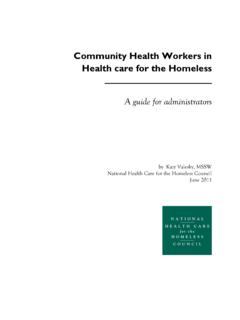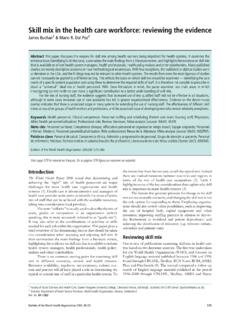Transcription of Outstationed Eligibility Workers at FQHCs: A Look at Cost ...
1 TACHC Policy Papers 5900 Southwest Parkway, Bldg 3, Austin, TX 78735 Ph: 512-329-5959 Fax: 512-329-9189 October 13, 2006, No. 1 For more information: Katie Parker Coburn, Outstationed Eligibility Workers at FQHCs: A Look at cost -Effectiveness Revenue from insured patients is crucial for the financial viability of Federally Qualified Health Centers (FQHCs). The Federal Outstationed Eligibility worker program in Medicaid offers a way to bring Medicaid revenue to FQHCs and provide the community with an important resource for public benefit Eligibility . About half (23) of Texas FQHCs take advantage of this resource. The other half do not, perhaps because of misconceptions about the cost of having an Outstationed Eligibility worker at their center. What is an Outstationed Eligibilty worker ?
2 How much do they cost the FQHCs that host them? What value do they provide the fqhc , fqhc patients, and the community? Background of the Program Section 1902 of the Social Security Act requires states to place Eligibility Workers in stations other than state benefit offices: SEC. 1902. [42 1396a] (a) A State plan for medical assistance must (55) provide for receipt and initial processing of applications of individuals for medical assistance under subsection (a)(10)(A)(i)(IV), (a)(10)(A)(i)(VI), (a)(10)(A)(i)(VII), or (a)(10)(A)(ii)(IX) (A) at locations which are other than those used for the receipt and processing of applications for aid under part A of title IV and which include facilities defined as disproportionate share hospitals under section 1923(a)(1)(A) and Federally-qualified health centers described in section 1905(1)(2)(B)[12]1 The federal government found that outstationing of Eligibility Workers was an effective strategy to enroll children and families into public benefits for which they are eligible.
3 In particular, they found Eligibility Workers stationed in health care environments that serve low income population help families with access to medical assistance without having to visit a state welfare office. As a State Medicaid Director letter dated January 18, 2001 states, .. many people, such as homeless persons, frequently do not consider health coverage until a need for health care 1 #a55 1 services arises. The opportunity to apply at the provider site can greatly facilitate enrollment in these circumstances. 2 The Social Security Act specifically requires States to place Outstationed Eligibility Workers (OEWs) at each Disproportionate Share Hospital (DSH) and each fqhc participating in the State s Medicaid Program. As facilities that experience a high volume of service to children and pregnant women, the Federal government encourages States to place OEWs at each fqhc site.
4 The regulations, however, provide a great deal of flexibility in how States implement their individual outstationing programs. Instead of finding that all fqhc sites are high volume providers to low-income children and pregnant women, Texas defines a high-volume site as one where the OEW generates roughly twenty benefit applications per week. Sites that qualify as high-volume under this definition are entitled to an OEW at no cost to the health center. Before placing the OEW in an Outstationed site, the Health and Human Services Commission (HHSC) assesses the volume of application activity at the local state benefit office to determine whether the fqhc requesting the worker qualifies as a high-volume provider according to the state definition. For sites that already have Workers , the state analyzes data from monthly reports provided to regional managers to track the number of determinations made by the Outstationed worker .
5 However, even if a site does not qualify as a high-volume site, the fqhc may still request having an OEW onsite. FQHCs who do not qualify as high-volume sites are required to pay 50% of the salary and benefits for the OEW. What does an OEW do at an fqhc ? An OEW at an fqhc operates precisely as a worker in a state or local benefit office operates. Indeed, the OEW is a state employee rather than an employee of the health center. This distinction is key as only state employees can certify a person eligible for state benefits. An OEW at an fqhc assists clients with state benefit applications and certifies them eligible for those benefits. Given the location, OEWs at FQHCs primarily certify children and pregnant women for Medicaid benefits. The state requires OEWs certify clients eligible for TANF, Food Stamps, and Medicaid any program for which women and children are eligible.
6 Whether or not the OEW actually certifies all these programs varies from center to center and region to region, depending on regional administration of the Typically, OEWs in FQHCs focus on Medicaid. They do not certify applications for the Children s Health Insurance Program (CHIP). They can, however, assist clients with their applications and refer the cases to the state for certification. OEWs at FQHCs are connected through the TACHC network directly into HHSC s Eligibility system so they can certify applications in real time. This connectivity represents a $750 per month value to the health centers. There is considerable flexibility in each fqhc s outstationing arrangement. One OEW may work full time at one site. Or, one OEW could rotate among several fqhc sites. Alternatively, one fqhc may host multiple OEWs to staff several sites simultaneously.
7 Currently, five FQHCs in Texas have more than one OEW operating at their various sites. 2 State Medicaid Director Letter #01-008, Department of Health and Human Services, Health Care Financing Administration, January 18, 2001. 3 TACHC member survey, August, 2004. 2 Who pays for the OEW? OEWs provide crucial community services, because as the Federal government indicated, many families do not consider health coverage until the need for the service arises. While community benefit is certainly important, the economic value of the OEW must be considered in relation to the cost for their services. In Texas, there are two different scenarios that cover the cost of an OEW. As outstationing is a federal requirement, the federal government pays the administrative match of 50% of the salary and benefits for the worker .
8 At high-volume sites, defined by the state as generating roughly twenty applications per week, the state pays the other 50% of the OEW s salary and benefits. According to HHSC, about 20% of FQHCs who have OEWs host the Workers at no cost to the health center. At other sites not deemed high-volume, the fqhc must pay the state s portion of the salary and benefits for maintaining the worker at its site. Medicaid revenue generated by the OEW worth well outweighs the cost of hosting the worker Consider the following scenario represented in the chart below. Because it is generally considered a preferable worksite, OEWs at fqhc tend to be fairly experienced Eligibility Workers . As the state tightens its Eligibility budget to implement its new Integrated Eligibility and Enrollment (IEE) system, fqhc sites are particularly desirable as Eligibility positions are being downsized.
9 Assuming a 10-year experienced Eligibility worker , HHSC estimates her total salary and benefit package at $64,410 annually. Therefore, the cost to the fqhc is $32,205. The state also charges a $285 per month program administration fee. 4 Therefore, the total annual cost of the OEW to the health center, not including facility costs for housing the worker is $35,625. The average OEW stationed at an fqhc processes 956 applications per year, or roughly 80 applications per month. Of these, an average of 667 applications are approved; again, roughly 56 applications per 4 Salary data reported by HHSC Office of Eligibility Services, August 14, 2006. 5 Calculated from HHSC Office of Eligibility Services report for OEW output at FQHCs.
10 Numbers represent data from April 2005-March 2006. 3 Annual Monthly Average cost to fqhc of 10-year experienced OEW (includes $32,205 salary and benefits plus $285/month administrative fee to the state) $35,625 $2, Average Medicaid Encounter Rate for FQHCs $1546 Average Number of Approved Medicaid Applications Certified by OEWs stationed at FQHCs in Mar 05-Apr 06 667 56 Additional Revenue (Encounter rate X Number of approved applications) $102,718 $8,624 Net Gain (New Revenue cost of OEW) $67,093 $5, Assuming a scenario that each newly eligible client will receive billable health services at the fqhc once during the year after his or her certification, FQHCs can expect an average of $67,093 in annual Medicaid revenue that they may not have received without the Eligibility worker onsite.







